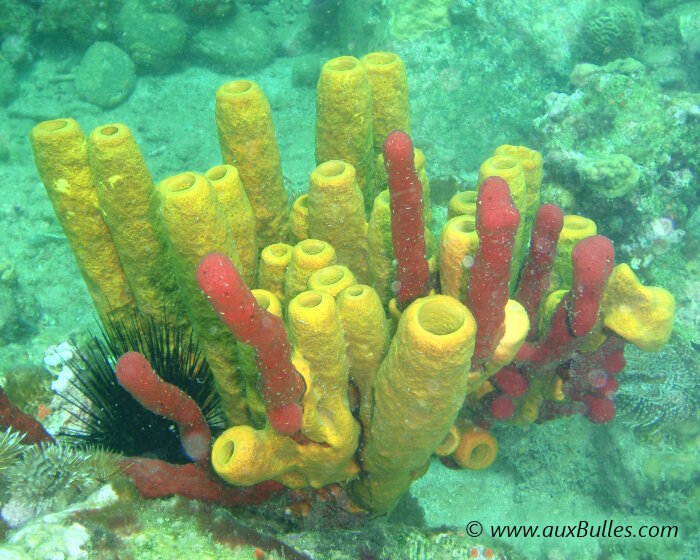Sealife guideThe marine sponges
Last updated on 09/03/2025 at 11:25 PM
The phylum of marine sponges includes 3 classes and is close to 10,000 species.
These different classes are primarily characterized by the nature of their skeleton: calcareous, siliceous or made of spongin alone:
- the demosponges
- the glass sponges or hexactinellids
- the calcareous sponges or calcarea
Sponges are considered the simplest multicellular animals or metazoans: they lack a nervous system, digestive tract and circulatory system.
Sponges are sedentary and live attached to a substrate, sometimes mobile, like a crab's shell or a hermit crab's shell.
Taxonomy
- Common name: Sponge
- French name: Eponge, porifére, spongiaire
- Scientic name: Porifera
- Class: 3 classes
- the demosponges
- the glass sponges or hexactinellids
- the calcareous sponges or calcarea
Range
Marine sponges are found in all the seas and oceans of the planet.
Habitat
Marine sponges are benthic, sedentary animals that live attached to a substrate, sometimes mobile, like a hermit crab's shell.
Marine sponges can be found at all depths.
Description
Marine sponges come in various colors and shapes: encrusting, perforating, shrub-like, ball-shaped, cup-shaped, 'brain coral'-like, tube-shaped, vase-shaped or barrel-shaped for the larger ones.
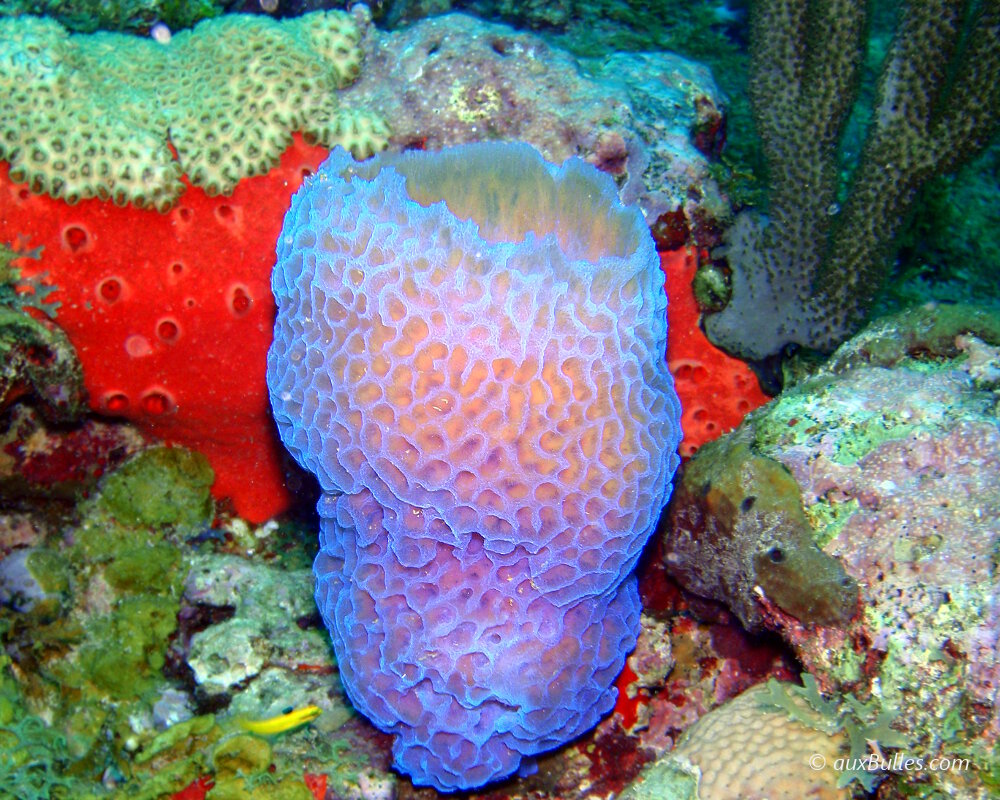
A vase-shaped marine sponge
Sponges have the ability to adapt their shape to the current conditions and the nature of the substrate.
The structure of all sponges is based on an aggregate of cells that form 'small bags'.
This sac-like structure has a wall, more or less complex depending on the presence or absence of a network of peripheral water circulation canals, consisting of 2 membranes:
- the external membrane or ectoderm
- and the internal membrane or endoderm
These two membranes are separated by a gelatinous layer reinforced by spicules. The chemical composition of the spicules determines the sponge's family classification.
The cells constituting the external membrane are called pinacocytes, while those of the internal membrane are called choanocytes and are responsible for reproduction.
The surface of the external wall is perforated by inhalant pores. Through these pores, seawater enters to supply a central cavity, either directly or indirectly through a large network of canals that communicate with chambers containing choanocytes before draining into the central cavity.
The central cavity is called the atrium and opens to the outside through an opening called the osculum, which allows seawater to be expelled.
The complexity of seawater circulation through the wall has led to a classification into 3 types of sponges:
- the Ascon type characterizes sponges with a simple wall
- the Sycon type characterizes sponges with a wall featuring a simple network of peripheral water circulation canals
- the Leucon type characterizes sponges with a wall featuring a complex network of peripheral water circulation canals
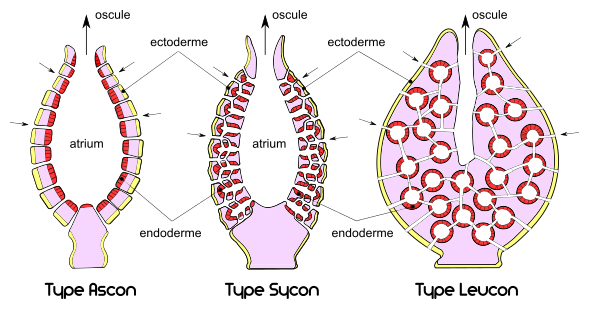
The different types of sponges: Ascon, Sycon, and Leucon
The wall of this bag is also perforated due to the presence of perforated cells or porocytes distributed across its entire surface, allowing water to enter inside.
Food chain
Diet
Unable to move to capture their food, sponges must bring it to them through a system of water circulation and filtration.
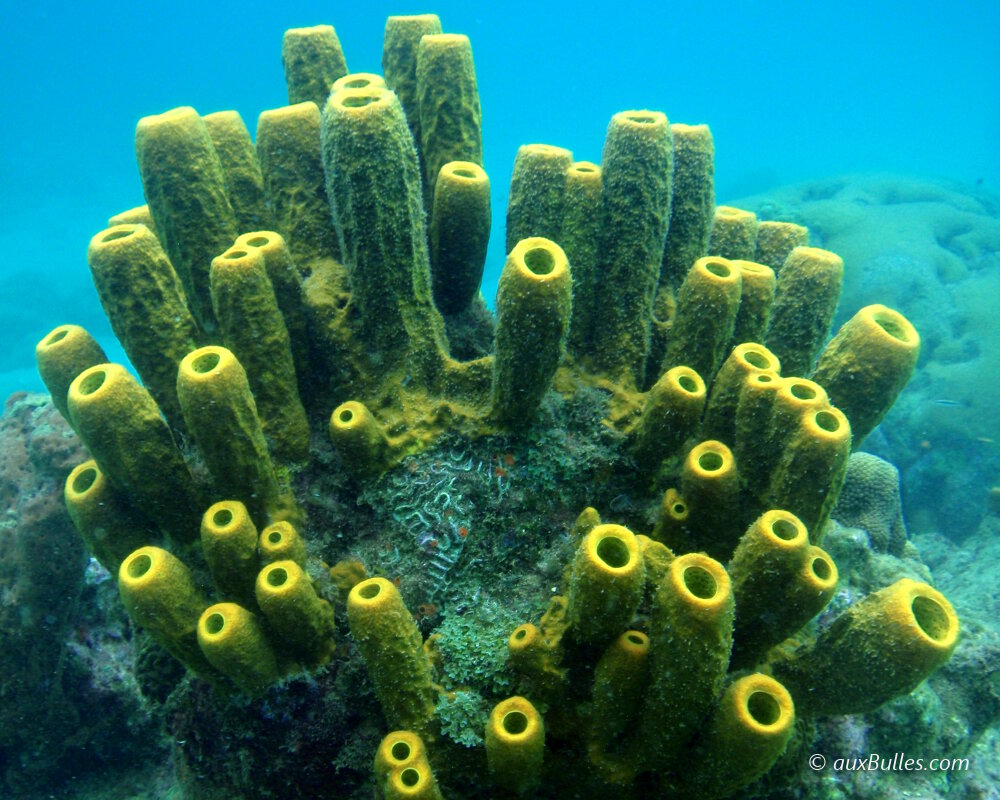
The sponge constantly filters seawater to feed
Water is inhaled through the pores, then filtered and expelled through the osculum. The sponge is capable of filtering several thousand times its own volume of water per day.
The mobile flagellated cells called amoebocytes, which line the entire internal wall of the sponge, ensure the distribution of nutrients among all the cells.
Predators
The main predators are nudibranchs, starfish, some fish and sea turtles.
Reproduction
Several types of reproduction can be observed in sponges:
- sexual reproduction: sponges are hermaphrodites and both male and female gametes are released at the level of the choanocytes.
- reproduction by budding: a fragment of the sponge detaches to give birth to a new sponge.
Did you know ?
The natural bath sponge you find in stores is actually the skeleton of a demospong.
Tips for observing
- Identify the numerous openings
- Observe the shape of the sponge
Be careful of the formation of air pockets above caves or cavities, which are fatal for encrusting sponges covering the ceiling.
Diver's Guide
The phylum of marine sponges includes 3 classes: demosponges, glass sponges and calcareous sponges, totaling 10,000 species.
The most well-known sponge to the general public is the demospong whose skeleton is sold as a natural bath sponge.
Discover marine sponges
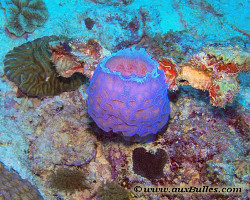
Azure vase sponge
(Callyspongia plicifera)
(Callyspongia plicifera)
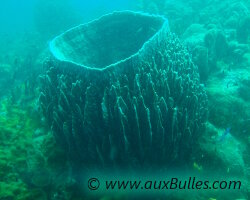
Caribbean giant barrel sponge
(Xestospongia muta)
(Xestospongia muta)
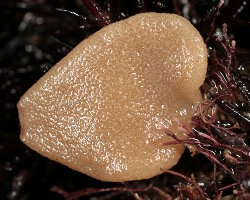
Compressed purse sponge
(Grantia compressa)
(Grantia compressa)
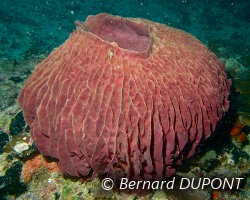
Giant barrel sponge
(Xestospongia testudinaria)
(Xestospongia testudinaria)
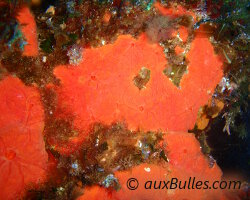
Orange-red encrusting sponge
(Crambe crambe)
(Crambe crambe)
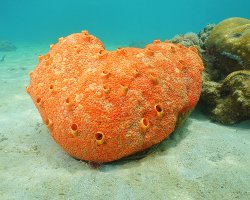
Rred boring sponge
(Cliona delitrix)
(Cliona delitrix)
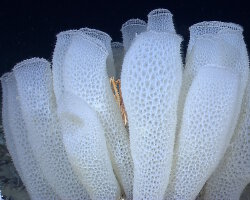
Venus flower basket
(Euplectella aspergillum)
(Euplectella aspergillum)
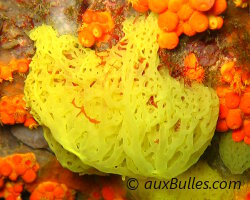
Yellow sponge Clathrina
(Clathrina clathrus)
(Clathrina clathrus)
Our latestUpdates
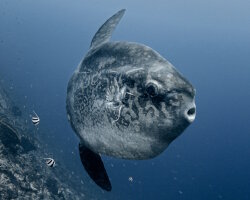
Friday, September 5th 2025
The bump-head sunfish
Learn about the bump-head sunfish (Mola alexandrini), the world's heaviest bony fish, its habitat in tropical and temperate oceans, diet of jellyfish, deep-water behavior and record size over 6,000 lbs.
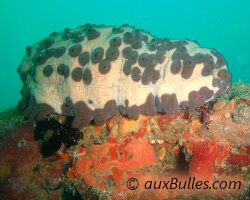
Wednesday, September 3rd 2025
The chocolate chip sea cucumber
The chocolate chip sea cucumber has a massive cylindrical body that is beige in color, covered with a set of dark brown pustules resembling chocolate chips that protrude slightly from the surface, giving it a resemblance to a cookie, hence its french name. It can reach a length of about 12 inches when fully grown.
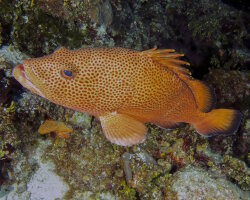
Monday, September 1st 2025
The red hind grouper
The red hind grouper has a distinctive appearance, usually beige to brown in color, with numerous red or brown spots covering its entire body and the base of its fins. It is often found in the shallow waters of coral reefs and rocky areas, where it hides in crevices and cavities.
Photo of the Day
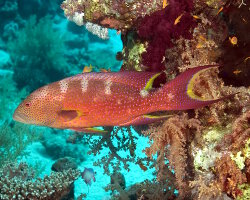
Mérou croissant de lune
(Variola louti)
(Variola louti)

